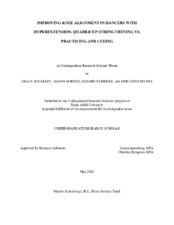Improving Knee Alignment in Dancers With Hyperextension: Quadricep Strengthening vs. Practice and Cueing

View/
Metadata
Show full item recordAbstract
The purpose of this study is to identify the most effective method to correct a dancer’s hyperextension at the knee joint. Many dancers are hyperextended at the knee joint, which is defined as the ability for their knee to extend past 180°. This causes the knee joint to become unstable as dancers’ reliable functionality decreases the further past 180° the knee can extend. This instability can cause a range of ligament injuries as well as provide a base for many alignment issues. The majority of dancers are not aware of their hyperextension until they enter a collegiate level dance training program. After years of training in hyperextension, it is difficult for the dancer identify the neutral position of the knee. Collegiate level dancers were split into a control group, a strength training group, and a cueing group. The control group participated in pre and post testing and continued regular activity throughout the study. The strength training group performed exercises 3 times a week for 6 weeks targeting the quadriceps, hamstrings, and rotator muscles. The cueing group performed ballet combinations 3 times a week for 6 weeks that are centered around controlling instability of the standing leg while being provided internal and external based verbal cues to correct their knee hyperextension. Both intervention groups were monitored during the training to evaluate proper alignment and engagement. The pre and post-tests measured passive and active knee hyperextension, video analysis of dance movements focusing on the standing leg, and a survey allowing the participant to self-report the perceived level of success in correcting hyperextension at the knee. The expectation is that the cueing group will have a greater level of success in correcting hyperextension in technique, thus lowering the probability that a dancer will sustain an injury to the ligaments of the knee.
Citation
Bulkeley, Grace Kathryn; Noreen, Naomi; Riddle, Elisabeth; Rivera, Mercedes (2021). Improving Knee Alignment in Dancers With Hyperextension: Quadricep Strengthening vs. Practice and Cueing. Undergraduate Research Scholars Program. Available electronically from https : / /hdl .handle .net /1969 .1 /188476.

